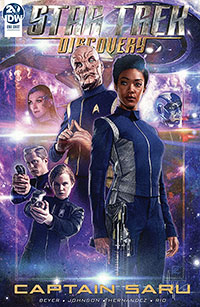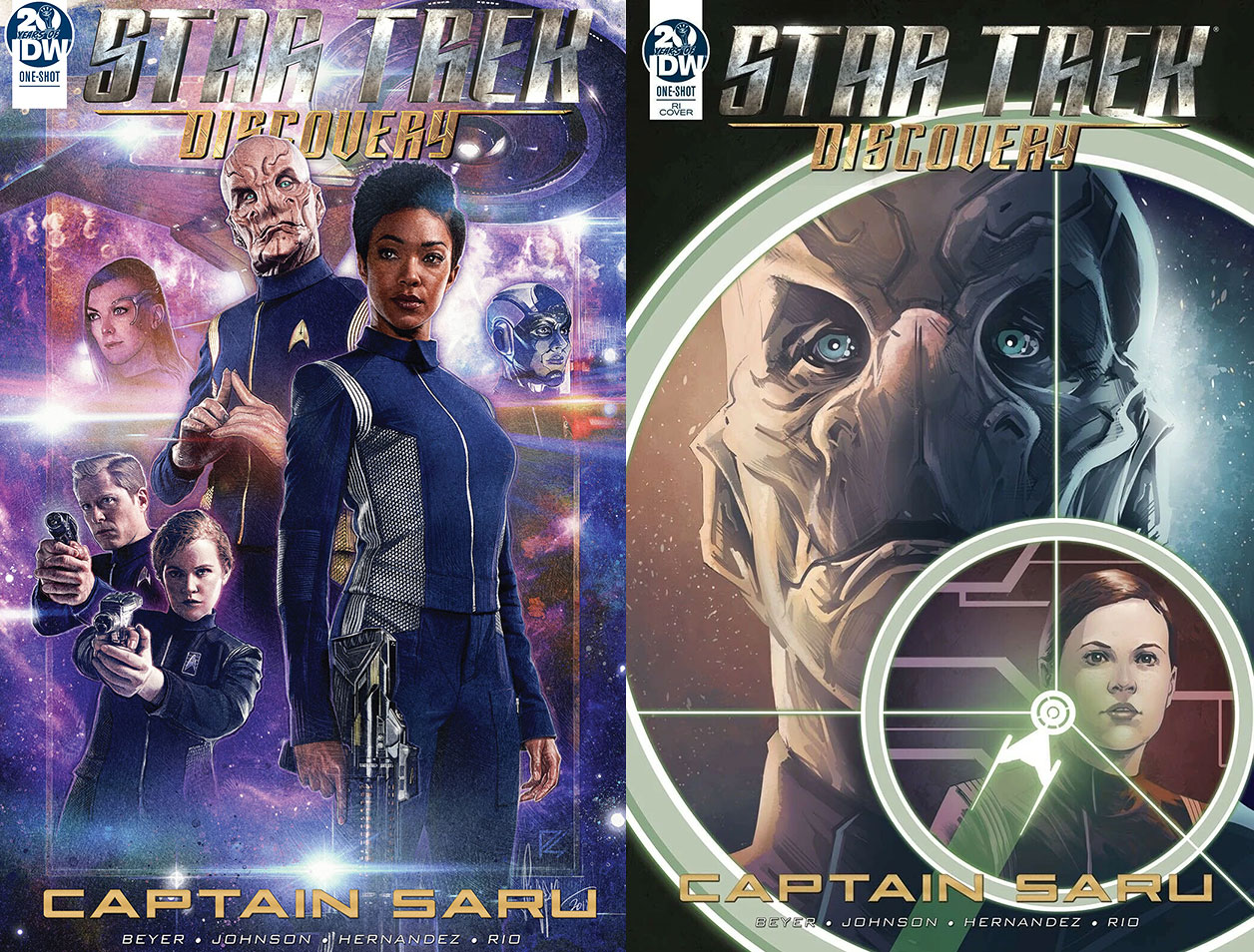Out of all the characters in CBS’s latest iteration of Star Trek, Saru has to be the most iconic and interesting Discovery character. A member of a species whose driving principle is fear (at least, until recently), he seems to be a character you would least expect to find on board a starship, exploring the unknown.
Yet here he is, and this one-shot title from IDW Publishing gives us greater insight into his background through Star Trek: Discovery — Captain Saru.
Discovery writer Kirsten Beyer and veteran Star Trek comic writer Mike Johnson join forces once again to bring us this incredibly detailed and authentic story that sees its validity measured not simply by the talent and qualifications of the writers, but on the foundation of other works as well.
To add, we also get a chance to appreciate Saru more as this critical juncture of Discovery’s history, set before the arrival of the USS Enterprise and after most of the significant events of the show’s first season.
A lot of Johnson’s recent Trek work has seen it primarily focused on Discovery stories. This is a good thing. Given his long history of writing Trek comics, Johnson has an accurate take on spinning new stories and a good foothold in canon. Combined with Kirsten Beyer, who has literally written the book on Discovery, they’re a powerful force for providing a story in the new Star Trek mythos that can bridge the gap between canonical proponents and those who say Discovery is otherwise.
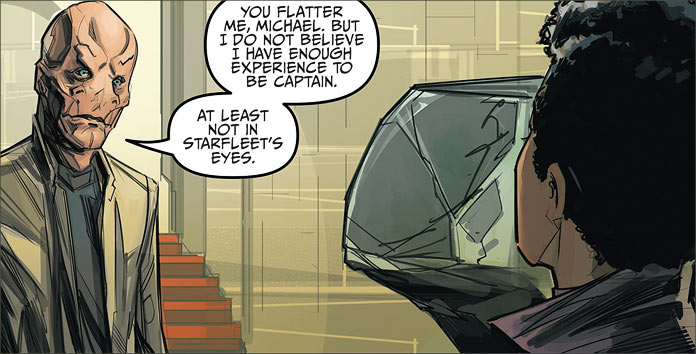
It’s a moot argument; as much as fans feel ownership over this franchise, it really isn’t theirs to affect. Fans are free to like what they want; point out inconsistencies wherever they like, but in the end, it’s the creators who have been placed in stewardship over this property who tell the story.
Johnson and Beyer are writers who have their feet planted firmly in Trek lore. While Bryan Fuller can be attributed to being the creator of Saru, Kirsten Beyer is about as close to the source as possible when it comes to interpreting this complicated character. Johnson’s knowledge ranges all the way back to the Original Series. If there’s ever a writing team who understands the past and future of this franchise, it’s this one.
In Captain Saru, we see that clearly. I like seeing the personal friendship between Saru and Burnham. It gives me greater insight into their relationship on screen. I can understand from this comic more why Saru and Michael are close. The interplay and dialogue between the two are very familiar and makes them both more endearing characters. Burnham’s knowledge of Saru’s blueberry dream is an aspect of that endearment.
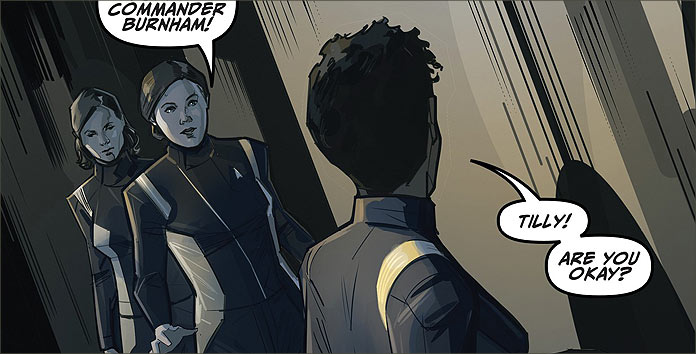
During the course of the story, Burnham’s deference to Saru is not just a case of Starfleet protocol, it’s a matter of respect. She clearly respects his orders and follows them to the letter. While it can be said that perhaps Burnham has learned her lesson by now, then this comic gives us the chance to see that lesson learned.
It’s also of note that both Johnson and Beyer make use of referencing Star Trek novels, more specifically, Fear Itself and A Way to the Stars in this story. This widens Discovery’s own base and provides greater context for the story. This also validates the material as Discovery continues to progress.
I also love that the antagonists in this story are Orions. Orions are my favourite race in Star Trek, mostly because they really haven’t been talked about a lot. We saw two Orions in classic Trek, a few in Enterprise, but we saw more of them in DISCO. For me, they’re a stark connection back to the Original Series and extends the canonical presence in Discovery.
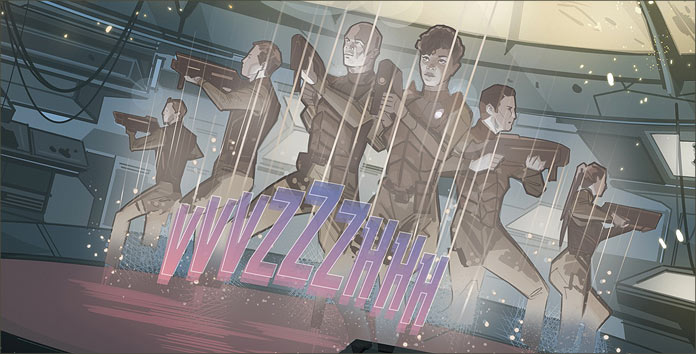
We also get to see more of Saru’s resolve and inventiveness. While his solution to the problem of the occupied ship may not be one of tactical genius and flair, it is a solution that would validate everything we know of this unique character to date. He hides, he sneaks, he makes use of deceptive techniques that would be fully consistent with a species used to being hunted and preyed upon. We can appreciate his command style and his decisions with more insight because of this adventure and it is greatly entertaining.
Angel Hernandez is the artist for this book. Hernandez’s work has never failed to disappoint me. Next to Tony Shasteen, his likenesses are the most accurate out of the pencillers IDW has on hand for Trek books. It’s also a challenge to draw the Kelpien’s facial features and it’s clear that Hernandez’s skill is more than enough to meet that particular challenge.
- There are only two covers for this book, with the standard cover art by Paul Shipper — it’s completely unreal. It’s a striking piece of art in which every physical detail of the cast members has been rendered accurately to an insane degree. I’m not overly familiar with Shipper’s work, but this is a first impression that has made me a fan. I have to say that this one is my favourite out of the two. I’d like to see more of his work in the future.
- The retailer-incentive cover is by Angel Hernandez and it also fails to disappoint. With the enlarged focus on Saru’s features, you can easily get a sense of Hernandez’s accuracy. Every ridge and cranial nook is visible and Saru’s eyes certainly catch your attention. The smaller image of Tilly conveys a sense of their relationship and makes this cover a very warm and personable one.
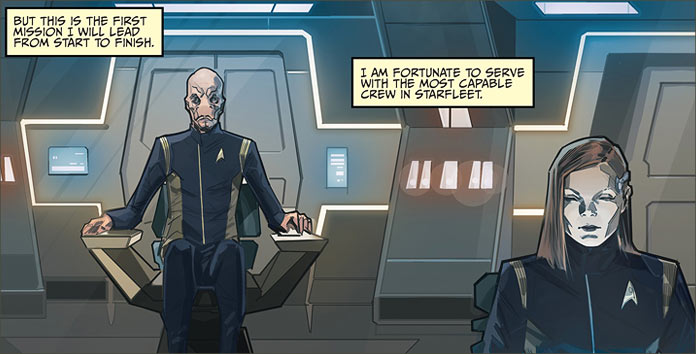
We get a greater sense of appreciation of Saru from this story. Far from the token alien species on the bridge, Saru is a creature capable of great talent and bravery, much more than he was initially promised to be.
A creature (formerly) driven by fear, both Johnson and Beyer have shown fans how he can turn that into a tactical advantage. He has captured the attention of Star Trek: Discovery fans and this comic really gives him a chance to endear him even more to the fans.

